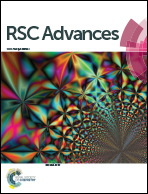Novel stereocontrolled amidoglycosylation of alcohols with acetylated glycals and sulfamate ester†
Abstract
A regio- and stereo-controlled, one-pot amidoglycosylation of alcohols has been achieved using O-acetylated glycals, trichloroethoxysulfonamide, and iodosobenzene in the presence of a rhodium(II) catalyst. The reaction would proceed via stereoselective intermolecular aziridination of the glycal.


 Please wait while we load your content...
Please wait while we load your content...